23 May 2023
Bird update May 2023

Click to enlarge
Greetings friends … It’s been slow around the blog for some time now, and partly that’s due to being very busy with the spring semester, and partly due to a lack of inspiration. But I have been inspired to keep birding, and now that the books are closed on the semester, I have some time to sit and think and feel around for strands of creative inspiration. So I hope to boost productivity over the summer – maybe not to the glorious levels of the heyday of this blog, but at least to better than once-a-month posting.
Anyhow: I’m at 146 species for my county in 2023, and when I checked in with you a month ago, that number stood at 111. Spring migration is the main boon – lots of new species flushing through our forests and mountains. It’s great to have hummingbirds back, and the brilliant blue indigo bunting. I’ve tracked down a few rarities, but mostly it’s been backyard birding for me. I’ve slipped from my highest ranking of #2 down to #5, and then clawed my way back up to #3 again.

I have a walk I do — I call it my Bird Walk — That starts at my house, and then heads down a nearby gravel road, crossing through forest, riparian zones, and open grassland, before looping back through a soggy wetland and then my neighborhood lake, and this time of year that route will net me ~50 species in an hour or so of walking. It’s about 4 miles, depending how far down the gravel road I choose to push it.
I’ve been enjoying refamiliarizing myself with spring migratory bird songs, thanks to the Merlin app. There are also some rarer ones that I’ve learned since last year – the Yellow-breasted chat, for one. I definitely feel more aware of bird song now than I have been at any point. I’ve gained enough confidence to scowl when Merlin IDs the song as the wrong bird! Mostly it gets it right, and I learn more every day through repetition and practice.
I ended up canceling my UVA class due to low enrollment, which means plenty extra time for birding as spring segues into summer.
21 May 2023
Earthquake Storms, by John Dvorak
 I’ve come to the end of my run of reading John Dvorak’s geology books. This is the fourth one for me to consume, but it was apparently the first he wrote. The topic is earthquakes, specifically those that occur along the San Andreas Fault in California. I’ve read a fair bit, it feels like, about the San Andreas: Carl-Henry Geschwind’s history, Susan Hough’s books, and just yesterday I started Andrew Alden’s Deep Oakland, in which the San Andreas’s eastern neighbor the Hayward Fault takes the central role, but the San Andreas plays a supporting role. Dvorak’s book is overall an approachable summary of the geology and the geologists who figured out what we know about it. Andrew Lawson, Charles Richter, Kerry Sieh, and Tanya Atwater all have important contributions, and Dvorak tells their stories well, so far as I can tell. What gave me a bit of pause was that there’s one or two paragraphs about east coast geology offered in a sort of “compare and contrast” section, and I found much wrong there – both typos and what I would argue are errors of emphasis. The former were at least were obvious and plain, and should have been caught prior to publication. It shook my confidence in the rest of the book. Dvorak structures the book so that the big culmination is the idea of centuries-long “earthquake storms:” a series of big shocks and aftershocks as stress is transferred along a major fault and its neighbors and subsidiaries. The notorious sequence from 1939 to 1999 along the North Anatolian Fault in Turkey is cited as an example of this “storm” phenomenon, and it’s what Dvorak expects when the southern stretch of the San Andreas finally ruptures after so many years of accumulating tectonic stress. Not “the big one,” therefore; he’s expecting “some big ones.” An interesting take, and all too plausible. I’m very grateful that I got to see the southern portion of the San Andreas in person just a few months ago; it made reading Earthquake Storms feel more urgent and vital.
I’ve come to the end of my run of reading John Dvorak’s geology books. This is the fourth one for me to consume, but it was apparently the first he wrote. The topic is earthquakes, specifically those that occur along the San Andreas Fault in California. I’ve read a fair bit, it feels like, about the San Andreas: Carl-Henry Geschwind’s history, Susan Hough’s books, and just yesterday I started Andrew Alden’s Deep Oakland, in which the San Andreas’s eastern neighbor the Hayward Fault takes the central role, but the San Andreas plays a supporting role. Dvorak’s book is overall an approachable summary of the geology and the geologists who figured out what we know about it. Andrew Lawson, Charles Richter, Kerry Sieh, and Tanya Atwater all have important contributions, and Dvorak tells their stories well, so far as I can tell. What gave me a bit of pause was that there’s one or two paragraphs about east coast geology offered in a sort of “compare and contrast” section, and I found much wrong there – both typos and what I would argue are errors of emphasis. The former were at least were obvious and plain, and should have been caught prior to publication. It shook my confidence in the rest of the book. Dvorak structures the book so that the big culmination is the idea of centuries-long “earthquake storms:” a series of big shocks and aftershocks as stress is transferred along a major fault and its neighbors and subsidiaries. The notorious sequence from 1939 to 1999 along the North Anatolian Fault in Turkey is cited as an example of this “storm” phenomenon, and it’s what Dvorak expects when the southern stretch of the San Andreas finally ruptures after so many years of accumulating tectonic stress. Not “the big one,” therefore; he’s expecting “some big ones.” An interesting take, and all too plausible. I’m very grateful that I got to see the southern portion of the San Andreas in person just a few months ago; it made reading Earthquake Storms feel more urgent and vital.
26 April 2023
Bird update April 2023
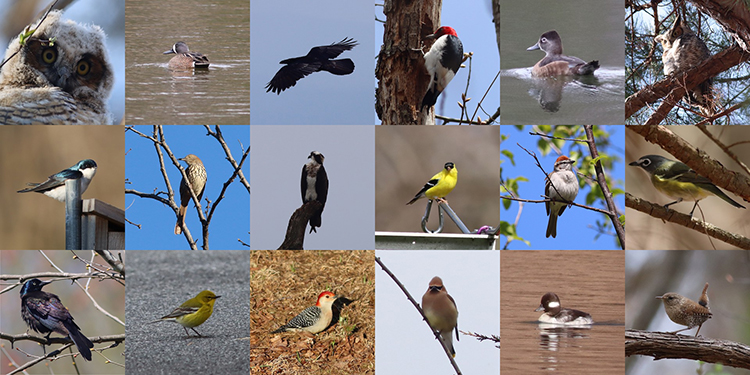
Click to enlarge
Another month gone by… and spring migration is cranking along!
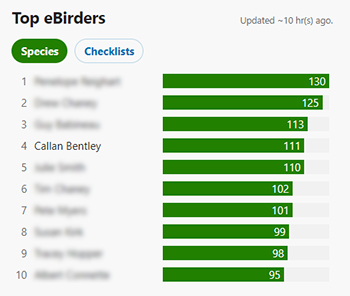
I’m up to a 111 species in my county for the year so far.
Migration is cranking right now, and there are lots of new species arriving each day (or just passing through en route to higher latitudes). I haven’t been making the most of it, frankly – due to family and work obligations, and a general end-of-semester feeling of exhaustion. But I have made the most of a few half-days here and there, and I feel pretty good about what I’ve been able to accomplish.
My “rank” has slipped to #4, and it was as low as #5 yesterday morning. But I feel like that’s still just fine, as my goal is merely to stay in the top 10.
Every year at this time (late April & early May), spring migration coincides with the end of the semester, and my life is split between the bliss of being in nature and the hassles of end-of-term grading, student issues, and May specific tasks, like graduation ceremonies. Summer won’t be as birdy, but at least it will be calmer!
26 March 2023
Bird update March 2023
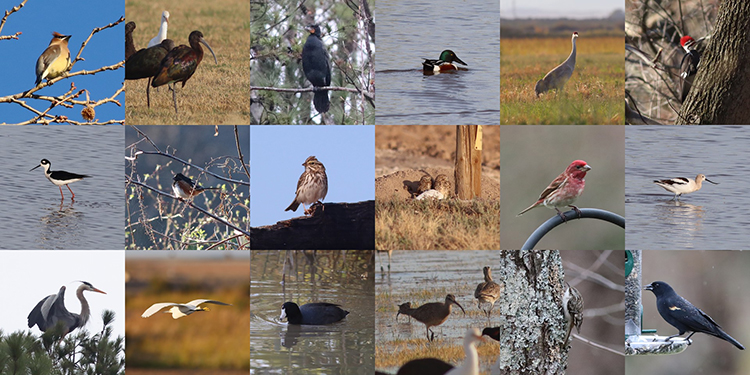
Click to enlarge
I’m still birding voraciously.
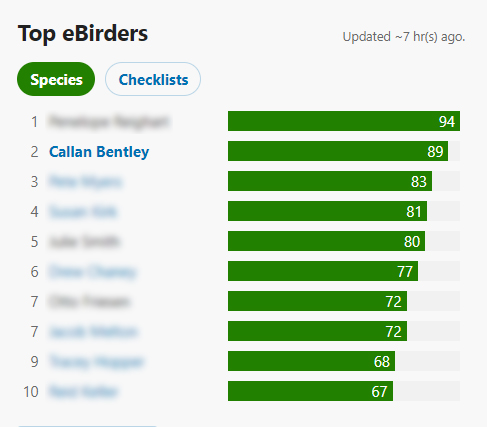
I’m up to 89 species in my county for the year. So that means I added a dozen since last month. A few of those are freshly-arrived migrants from southerly climes, and some are just me putting in the time to go rack up waterfowl at nearby lakes. I’ve maintained my high county ranking, which has oscillated between #4 and #2 this month.
A separate dose of birding was delivered when I led my annual spring break field course, which this year went to southern California. It was great to see roadrunners and phainopeplas there, but the highlight was visiting Unit 1 of the Sonny Bono National Wildlife Refuge, on the south shore of the Salton Sea, where I saw and heard all kinds of awesome birds, notably sandhill cranes and burrowing owls.
I was delighted last evening, back home in Virginia, to spot a sandhill crane migrating north. They are not common birds in this part of the world, and I wonder if I even would have been able to identify it if my brain hadn’t been “primed” by the sandhills in California two weeks previously. Honestly, I have no expectation that I’ll ever see a sandhill crane from my yard again – it seems very, very unlikely. I’m glad that I was wearing my binoculars when it happened to fly by; a good reminder that if you don’t keep the bins with you, you won’t be able to instantly deploy them when needed.
Spring migration has started; Louisiana waterthrushes and Brown thrashers are both back in the neighborhood. Soon the tanagers, vireos, and warblers will follow…
17 March 2023
Friday fold: Pinto Gneiss, varnished and un-
Last week, I was lucky enough to visit Pushawalla Canyon in the Indio Hills region of southern California. There, my colleague Kim Blisniuk (San Jose State University) led our students through an exercise mapping alluvial deposits as a way of constraining offsets along the Mission Canyon strand of the San Andreas Fault. I noted that much of the alluvium was sourced to the northeast, to the Little San Bernardino Mountains. Particularly striking to my eye was the Pinto Gneiss, whose foliation is frequently contorted into lovely folds, like this one:
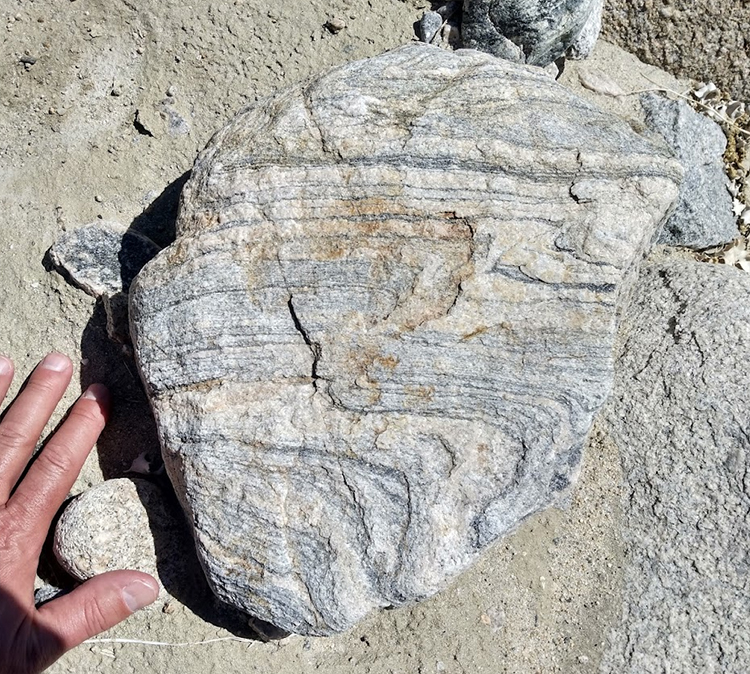
But on older alluvial terraces, desert varnish has accumulated, and the trace of the folded foliation is a bit harder to see:
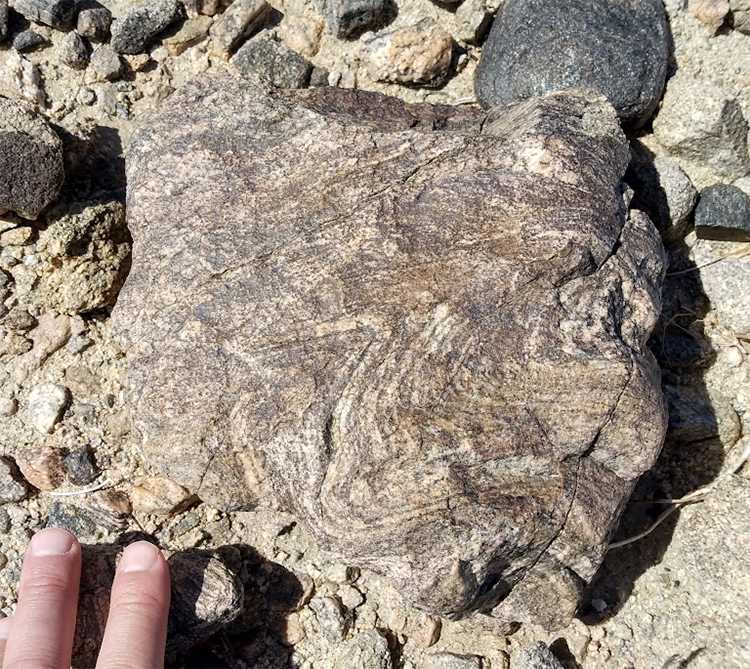
To me, this comparison/contrast between two similar boulders of gneiss offers a striking visual that qualitatively shows some alluvial deposits to be older, and others fresher. When quantitative methods are applied to constraining the ages of these deposits (10Be exposure ages coupled with U-series soil carbonate ages), rates of offset along the San Andreas can be calculated.
Happy Friday, and Slàinte Mhath!
10 March 2023
Friday fold: Painted Canyon
Greetings from southern California!
I’m running a spring break field course in the Mojave and Colorado desert. Here’s a pretty amazing fold pair in Palm Springs Formation, butted up against (darker) Mecca Formation along a fault.
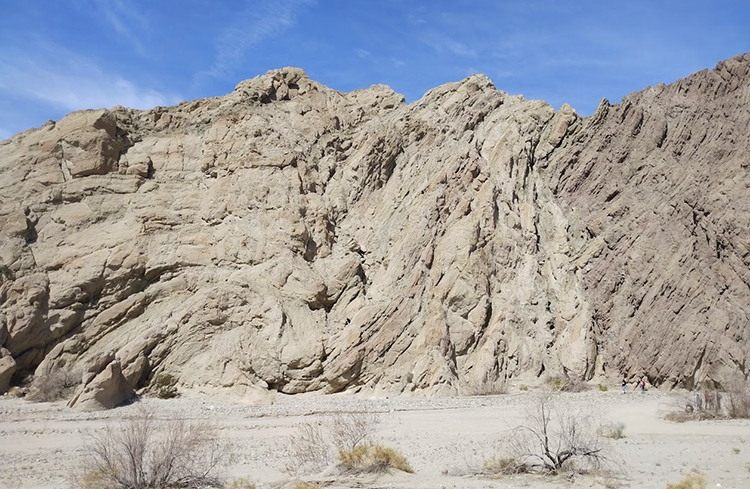
This is in Painted Canyon, in the Mecca Hills, a transpressional pop-up between the Painted Canyon Fault and the San Andreas Fault.
Happy Friday!
25 February 2023
Bird update February 2023

Click to enlarge
February has zipped by, but then again it’s a short month. I’ve continued birding intensively this month, so I’ll provide another update like I did last month. I’ve racked up 71 species this month, and pushed my 2023 total up to 77 (from January’s ending total of 66). The past few days have been very productive, as unseasonably warm temperatures have drawn north some early birds, such as tree swallows. Most importantly though, I’ve been putting in my time, making deliberate visits to local parks and lakes, and following “hot tips” of other birders’ reports via eBird.
 The result is that I’ve managed to meet my goal of staying in the top 10 for my county, with an annual running total of 77. Yesterday’s hot streak of sightings pushed me back up to the #2 slot, which is good because the week after next I’ll be in southern California for a week, which is great for southern California birds, but means I’ll be out of the game with regard to my home county species. I guess you could say I’ve “banked” some species to buffer my inevitable slip downward through the ranks in early March.
The result is that I’ve managed to meet my goal of staying in the top 10 for my county, with an annual running total of 77. Yesterday’s hot streak of sightings pushed me back up to the #2 slot, which is good because the week after next I’ll be in southern California for a week, which is great for southern California birds, but means I’ll be out of the game with regard to my home county species. I guess you could say I’ve “banked” some species to buffer my inevitable slip downward through the ranks in early March.
It’s worth pointing out that even though spring migration hasn’t yet begun, I’m already at 57 for my yard list, which is on par with some years’ total annual lists for my Fort Valley house. (The most I ever got there was 67.) Again, the birding’s better around Charlottesville, and also (again) I’ve been more deliberate and methodical about it all since moving here.
I should point out that I’ve let my obsession with the “checklist streak” on eBird drop. For me, it’s just too exhausting to insist on posting at least one checklist every day. I’ve got other things in my life that are more urgent. But some days, I put in half a day of birding, and enter in 5 or more checklists (from different locations) over the course of a few hours. So I’m not going to bird every day this year.
One new tool I’ve discovered in eBird is the “target species” list; a personalized list of species that a user hasn’t yet seen for a given place and given time of year. This helps me focus/prioritize where I want to spend my time. I’ve subscribed to a daily email that summarizes county reports from the previous day specifically for the species I haven’t yet seen for the year. It’s pretty powerful, and I’m grateful for its aid.
The mix of species is about to change, with the advent of the early stages of migration – some species will leave our area and head north, and new ones will flush in from the south. Stay tuned!
21 February 2023
Recent rocks
Trying to dredge up some blogging inspiration, but honestly I’m feeling underrested and overworked these days, and not particularly enthusiastic about writing. But here are some cool rocks I’ve seen lately; maybe you’ll find them interesting…
Antietam Formation quartzite at Sherando Lake, Virginia:

I was struck by how sugary the texture was, and the interesting joint patterns resulting in kind of bulbous forms.
Graded bed of bioclastic debris, Martinsburg Formation, near Mountain Lake, Virginia:

Several students and I took a trip down to the geology department at Radford University recently, and they took us out to see some cool local rocks, including this excellent bioclastic turbidite in the late-Ordovician Martinsburg Formation. I love that even the fossil debris can sort it out by size when dumped in a submarine basin.
Granite dike in biotite granite, Ragged Mountain Reservoir, Charlottesville, Virginia:

Ragged Mountain Reservoir is a nice place to see Mesoproterozoic-aged Blue Ridge basement complex. Here, you can see cross-cutting relationships between an older biotite-rich granitoid and a younger, more felsic granite that forms a tabular dike cutting across it.
Triassic fanglomerate of the Scottsville Basin, north of Scottsville, Virginia:

A beautiful poorly-sorted conglomerate/breccia that likely was deposited in an alluvial fan complex on the edge of the Mesozoic rift basin called the Scottsville Basin, a gash in the Earth that opened up upon the breakup of Pangaea and the birth of the Atlantic Ocean basin.
Kyanite quartzite of Baker Mountain, Virginia:

It’s hard not to love this rock. What gorgeous kyanite porphyroblasts! Absolutely stunning.
Blue quartz, Ragged Mountain Reservoir, Virginia:

Back to Ragged Mountain again for this one. I saw this last week while on a circum-reservoir hike in search of odd ducks. It has an interesting brecciated texture that I don’t totally understand. Any ideas, readers?
10 February 2023
Friday fold: Kelvin-Helmholtz waves in granite?
Reader Christian Gronau returns with another “guest Friday fold” submission.
Christian writes,
Greetings from a cold and wet west coast. A good time to root through old rock samples – and let the imagination run free …
The little compilation below strikes me as visually compelling (both photographs are mine) – but how likely is it that the suggested analogy has any merit ?
Would it have some entertainment value to post this triptych under your rubric of “Friday Fold”? I certainly would like to hear (your) expert opinion on the question raised.
The cut and polished cobble from a local BC beach is 10cm wide and consists of two common local rock types : typical Cordilleran granodiorite (bottom) and dark grey andesite. The latter forms extensive dyke complexes, cutting through the granodiorite in a number of styles, with hard linear to soft undulating contacts, including faulted and fragmented sections. The local dykes range from centimetres to many meters in width.
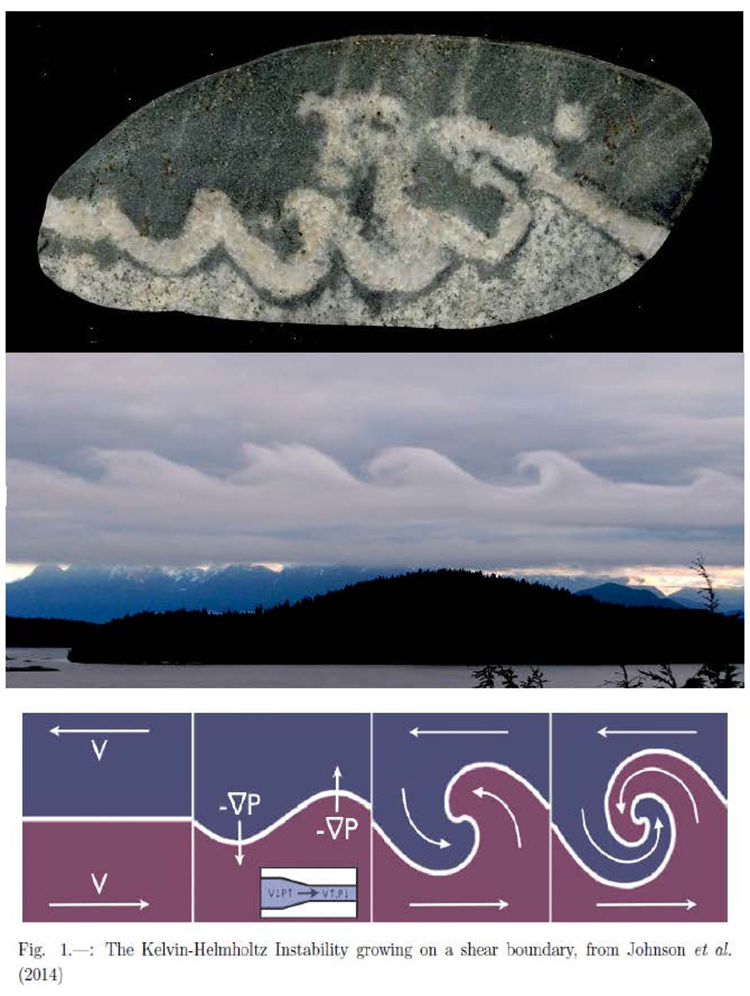
Certainly the visual match is spot-on! A neat example, and I would not be too surprised if a similar variation in rheology under the traction of simple shear induced these structures. What do other readers think?
Thanks for pitching in with the Friday fold, Christian!


 Callan Bentley is Associate Professor of Geology at Piedmont Virginia Community College in Charlottesville, Virginia. He is a Fellow of the Geological Society of America. For his work on this blog, the National Association of Geoscience Teachers recognized him with the James Shea Award. He has also won the Outstanding Faculty Award from the State Council on Higher Education in Virginia, and the Biggs Award for Excellence in Geoscience Teaching from the Geoscience Education Division of the Geological Society of America. In previous years, Callan served as a contributing editor at EARTH magazine, President of the Geological Society of Washington and President the Geo2YC division of NAGT.
Callan Bentley is Associate Professor of Geology at Piedmont Virginia Community College in Charlottesville, Virginia. He is a Fellow of the Geological Society of America. For his work on this blog, the National Association of Geoscience Teachers recognized him with the James Shea Award. He has also won the Outstanding Faculty Award from the State Council on Higher Education in Virginia, and the Biggs Award for Excellence in Geoscience Teaching from the Geoscience Education Division of the Geological Society of America. In previous years, Callan served as a contributing editor at EARTH magazine, President of the Geological Society of Washington and President the Geo2YC division of NAGT.